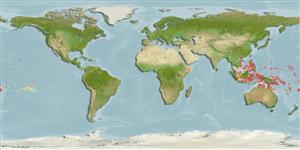>
Atheriniformes (Silversides) >
Atherinidae (Silversides) > Atherinomorinae
Etymology: Stenatherina: Greek, stenos =narrow + Greek, atherina, the Greek name for the eperlane; 1770 (Ref. 45335).
More on authors: Jordan & Richardson.
Environment: milieu / climate zone / depth range / distribution range
Ökologie
seewasser riff-verbunden; tiefenbereich 1 - 20 m (Ref. 86942). Tropical; 19°N - 20°S
Pacific Ocean: Sumatra and the northern Cook Islands, north to the Philippines, Caroline Islands, and Marshall Islands, south to Fiji.
Size / Gewicht / Alter
Maturity: Lm ? range ? - ? cm
Max length : 11.0 cm TL Männchen/unbestimmt; (Ref. 9760)
Kurzbeschreibung
Morphologie | Morphometrie
Rückenflossenstacheln (insgesamt): 5 - 8; Rückenflossenweichstrahlen (insgesamt): 8-10; Afterflossenstacheln 1; Afterflossenweichstrahlen: 9 - 12. Vomerine teeth forming a characteristic T pattern. Ascending process of premaxilla long, extending past orbit into interorbital space; lateral process very long and pungent. Gill rakers long and slender, longer than half the diameter of pupil. Interdorsal scales 8-10. Distinct crescentic mark present on snout immediately in front of eye; upper part of midlateral band terminating as half crescent on upper lobe of caudal fin.
Preferred habitat appears to be deeper enclosed atoll lagoons, reefs, coastal waters and harbors. May gather in schools at night when attracted to light but generally not found in very large numbers. May be taken as food by larger commercial species (Ref. 9760).
Life cycle and mating behavior
Geschlechtsreife | Fortpflanzung | Ablaichen | Eier | Fecundity | Larven
Oviparous, distinct pairing during breeding (Ref. 205).
Myers, R.F., 1991. Micronesian reef fishes. Second Ed. Coral Graphics, Barrigada, Guam. 298 p. (Ref. 1602)
IUCN Rote Liste Status (Ref. 130435)
Bedrohung für Menschen
Harmless
Nutzung durch Menschen
Fischereien: weniger kommerziell; Köder: occasionally
Mehr Information
Alter/GrößeWachstumLänge-GewichtLänge-LängeLängenhäufigkeitenMorphometrieMorphologieLarvenLarven Pop.Dyn.RekrutierungDichteBRUVS
ReferenzenAquakulturAquakultur ProfilZuchtlinienGenetikElectrophoresesVererbbarkeitKrankheitenVerarbeitungNutrientsMass conversion
PartnerBilderStamps, Coins Misc.LauteCiguateraGeschwindigkeitSchwimmstilKiemenoberflächeOtolithsGehirngrößeSehfähigkeit
Tools
Zusatzinformationen
Download XML
Internet Quellen
Estimates based on models
Preferred temperature (Ref.
123201): 26.7 - 29.3, mean 28.7 °C (based on 1304 cells).
Phylogenetic diversity index (Ref.
82804): PD
50 = 1.0000 [Uniqueness, from 0.5 = low to 2.0 = high].
Bayesian length-weight: a=0.00562 (0.00244 - 0.01296), b=3.11 (2.91 - 3.31), in cm total length, based on LWR estimates for this (Sub)family-body shape (Ref.
93245).
Trophic level (Ref.
69278): 3.3 ±0.4 se; based on size and trophs of closest relatives
Widerstandsfähigkeit (Ref.
120179): hoch, Verdopplung der Population dauert weniger als 15 Monate. (Preliminary K or Fecundity.).
Fishing Vulnerability (Ref.
59153): Low vulnerability (10 of 100).
Nutrients (Ref.
124155): Calcium = 109 [59, 211] mg/100g; Iron = 0.693 [0.404, 1.257] mg/100g; Protein = 19.4 [17.1, 21.8] %; Omega3 = 0.14 [0.06, 0.36] g/100g; Selenium = 21.7 [10.3, 49.4] μg/100g; VitaminA = 181 [57, 527] μg/100g; Zinc = 1.82 [1.23, 2.59] mg/100g (wet weight);
